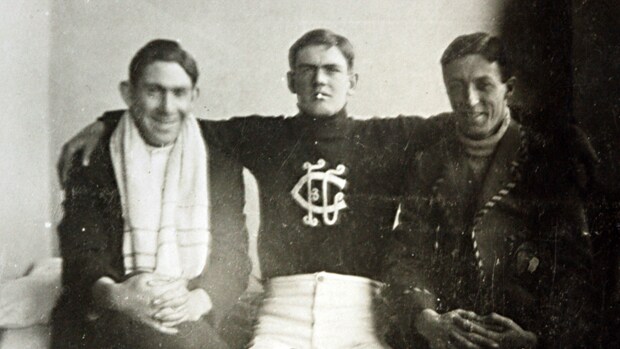Private William Martin Rogers
10th Machine Gun Company
Died Rouen, France, September 22, 1918,
Aged 25 years
Three games for Carlton, 1913
William Martin (Willie) Rogers was a defender from Wonthaggi who played three games for Carlton in 1913 after being recruited from Carlton District.
Five years later, and just three weeks before the Armistice was signed in November, 1918, Willie was critically wounded in action, and died the following day at the age of 25.
The story of ‘Willie’s military service was unknown outside his family until November 2007, when research revealed that a simple typing error had listed him in club records as William H. Rogers. No Australian with that name and initial served in the Great War, so his bravery and sacrifice was unrecognised until the truth was eventually discovered - ninety years after his death.
Willie was born at Woolamai in Gippsland in 1893, the second son of John and Mary Rogers. Four sisters completed a large working-class family. Willie and his older brother (also named John, after his father) were keen footballers who supported their family by leaving school early to take up work in local sawmills. Of the two, Willie showed the most promise on the football field as a dashing defender for Wonthaggi.
In 1913 – soon after the tragic death of his father – Willie journeyed to Princes Park to play VFL football with the Blues. He made his senior debut (wearing Tom Bell’s No. 28) against Geelong at Corio Oval on the King’s Birthday weekend in June of that year.
Willie played as a follower (second ruckman) and Carlton won by 15 points. He moved to a back pocket for his next match (a 27-point victory over Essendon at Princes Park) while his third and last game was a disappointing 47-point defeat by ladder leaders South Melbourne at the Lake Oval. Soon after that loss, Willie left Carlton and crossed to VFA side Brunswick.
Less than a year later, in August 1914, Europe was plunged headlong into a long and bloody war between Germany and her allies on one side, and France and the British Empire on the other. Australia’s men were quick to answer the call to arms, and within months, the first Australian troopships were on their way to Egypt.
Although she was already a widow, Mary Rogers sent both her sons to serve their country. John enlisted in July 1915, and Willie signed on in February of the following year. Willie was trained to be part of a three-man machine-gun team, embarking for England in May 1916. Six weeks later, he was pitched into action for the first time as two massive armies clashed in a series of offensives on France’s Western Front.
In October 1916, Willie’s ability was recognised with his promotion to Lance Corporal – on the same day as he was wounded for the first time. Hit in his left foot by a shell splinter, he was evacuated to England for treatment, and while recuperating from surgery, was sent to a training unit as an instructor.

William Rogers (centre) circa 1913 (Image courtesy Erin Forbes)
By June 1918, Willie had recovered enough to be posted back into front line service with the rank of Corporal. Aided by the entry of American troops, the tide of the war had turned in favour of the Allies by September, but losses on both sides were still horrendous.
On the 21st of September 1918, Willie was a temporary Sergeant in charge of a section of three machine-guns. Somehow – perhaps while advancing, or directing his men to a better position, he was caught in the open by enemy troops. They raked his position with their own automatic weapons, and Willie was critically wounded. Although his men recovered him alive, and he was evacuated to the nearest field hospital, Willie’s wounds were severe and he died the following day.
He was 25 years old.
Willie Rogers now lies - with many other sons of the Southern Cross - at St. Sever Cemetery extension, outside Rouen.
In a footnote to Willie’s story, his brother John also served his country with distinction.
Twice wounded in action himself, he was awarded a Military Medal for ‘acts of gallantry and devotion to duty while under fire’ at Polygon Wood, during two days of heavy fighting on September 20/21, 1917 - precisely twelve months before his brother’s death.
The citation for his award reads; ‘Private Rogers was a stretcher-bearer, and although separated from other bearers, did splendid work in tending the wounded when under the enemy barrage. From the time of advance up to the time of relief, this bearer worked continuously. Also when reliefs were being effected, he was of great assistance to the relieving Battalions, both as a guide to their positions and in organizing parties to remove their wounded. This latter work was carried out under heavy enemy fire.’
Happily, John Rogers survived the war. Although wounded in each arm on separate occasions, he was discharged from military service by a grateful nation in March, 1919.


